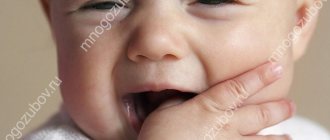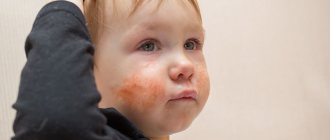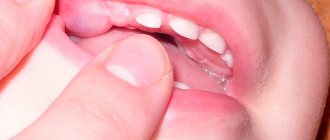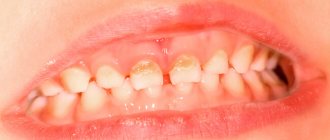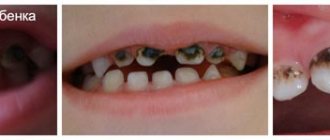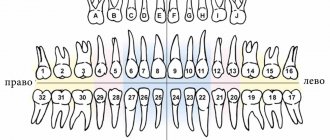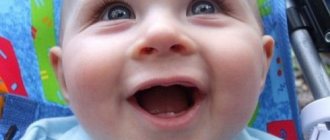How many teeth does a child have at 1 year of age? During this period, babies usually have 8 teeth. In order to determine the number of teeth required for a child at his age, dentists use the formula “M-4=K”, where M is the months, K is the total number of teeth.
- What processes occur during the growth of the first teeth? Deadlines ↓
- Symptoms indicating the imminent appearance of baby teeth ↓
- Causes of missing teeth or late eruption ↓
- How to alleviate the baby’s condition and help him endure the pain? ↓
- Tips for caring for teeth up to a year ↓
- Summing up ↓
The main factors influencing the appearance of the first teeth in children:
- Heredity. If both parents, for example, had their first tooth at an early age, for example at 4-5 months, then most likely this will be the case for their children together.
- Climatic living conditions. It is believed that in hot countries, toothy smiles in children appear earlier than in countries where the climate is more severe.
- Maternal nutrition during pregnancy and breastfeeding. Did the baby receive enough vitamins and nutrients, and what additional vitamins did the mother take?
- The course of pregnancy and complications during childbirth. Mineralization of baby teeth begins in utero in the mother. Some babies, approximately 1 in 2000, are born with a tooth already present, which should not frighten parents.
- And even such an insignificant point as the quality of drinking water.
All this in one way or another affects the time of appearance of the first molars, canines, etc.
What processes occur during the growth of the first teeth? Deadlines
Mineral salts fill the crowns of the teeth, and the root growth phase begins. After the roots stop growing, a period of calm begins for a while. Then baby teeth begin to fall out.
Baby teeth appear according to the schedule below, if there are slight deviations, do not worry. For stronger deviations from the deadlines, you should consult a doctor. At about six months the process of teething begins and at the age of three years it comes to an end.
The timing of teething in children under one year of age:
- At 6-7 months of age, the central incisors should appear - these are 2 teeth in the center.
- In 8-9 month old children, two upper, medial incisors erupt.
- At the age of 9-11 months, it is time for the two lateral incisors to appear on top.
- Closer to 11-12 months, two lower teeth grow on the sides.
In total, about 8 teeth should be counted by this date.
Timing of teething in children after the first year:
- At 12-18 months (1-.1.5 years), the first upper and lower molars (molars) appear.
- At 16-18 months (1.5 years), the upper and lower canines erupt.
- In 20-33 months (2-3 years) the period of growth of the second lower and upper molars, the so-called second molars.
Symptoms indicating the imminent appearance of baby teeth
Main symptoms:
- Redness and swollen gums.
- Heavy salivation.
- Increased excitability.
- Intestinal disorders.
- Fever, runny nose, cough.
- The child aggressively chews toys or bites the breast during feeding.
Some signs can be confused with an incipient viral or other disease, so you need to pay attention to all the symptoms and see a pediatrician if in doubt.
Causes of missing teeth or late eruption
Main reasons:
- Deficiency of minerals (calcium, vitamin D).
- Diseases of the gastrointestinal tract, rickets, thyroid diseases.
- Metabolic disease.
- The so-called congenital adentia, when the rudiments of teeth are absent
If teeth have not yet made themselves felt at 1 year of age, the doctor will take an x-ray. If rudiments (roots) are detected, he will most likely prescribe medications or a diet containing calcium and vitamin D, as well as phosphorus. If an x-ray shows the absence of tooth rudiments, then at the age of two years the child will have to have removable dentures, and at an older age - implants.
It is impossible to speed up teething, but it is quite possible to help the baby cope.
Baby 9 months: Feeding
At this stage, approximately half of the baby's total diet is baby food, and the other half is breast milk or formula.
At 9 months, the child can already eat something with his hands. You can give him small pieces of steamed vegetables or a ripe banana. You can also put a little yogurt in a spoon and invite your baby to bring it to his mouth. Most of this yogurt will likely end up on the counter or floor, so don't expect your baby to suddenly start feeding himself entirely. Monitor your baby when he tries to feed himself. Do not give him large or hard pieces - at this age children often do not chew food, but immediately swallow it and may choke.
We offer you an approximate daily diet for a nine-month-old baby, including baby food, breast milk or formula. This chart will also give you an idea of how much food an average nine month old baby needs per day.
How to alleviate the baby’s condition and help him endure the pain?
Recommendations:
- Prepare teethers in the form of toys. The most popular are food-grade silicone, as well as items filled with water that need to be pre-cooled.
- Take care of the baby's environmental hygiene. Because he puts everything in his mouth, and his gums are inflamed, there is a risk of infection.
- Gum massage can be done using your fingers or wet gauze.
- Give older children cookies or fruit more often.
- Special gels (Kalgel, Kamistad, Doctorbaby) give a short-term effect. You need to smear them not according to schedule, but when it hurts. Consult your physician before purchasing. Also, there are painkillers specifically for children (Dentokind).
- Apply to the chest more often , provide attention, play and distract.
- Ventilate the room more often for the overall well-being of the child.
- As an antipyretic, paracetamol is allowed for young children.
Reasons to call a doctor:
- increased body temperature over 39 degrees;
- loose stools more than 6 times with abnormal green or bloody stools;
- frequent vomiting;
- yellow or green runny nose;
- continuous tearful state;
- hematomas on the gums;
Young parents: How to go on vacation with your child
Are you going somewhere with the whole family? Traveling with a child presents certain challenges, but it is completely doable! Here's how to do it:
- Choose a quiet and private place without many distractions. It's best to go where you've already been.
- Don't plan too much for one trip. Instead, try to enjoy your vacation.
- Decide where the baby will sleep. If you're going to bring a folding crib, let your baby sleep in it a couple of nights before you go to get used to it.
- Try to replicate your home environment while traveling. Follow the same routine as at home, take your baby’s favorite toy with you.
- Stock up on wet wipes. They can be used to wipe your baby's face and hands, as well as surfaces in places where you will change diapers.
- If you have plane tickets, you might find it helpful to read this article on how to travel by plane with a small child.
- No matter how difficult it may seem, try to remain calm. If you feel good and like everything on the trip, your child will feel the same way.
Tips for caring for teeth up to a year
Early dental care can be turned into a game with your child.
Practicing good personal hygiene can prevent gum disease and tooth decay :
- Limiting sweets such as chocolate, gummy candies, sweet juices.
- Every day, wipe your gums and teeth with clean, damp gauze wrapped around your finger.
- After a year, you can already buy a children's toothbrush and toothpaste, and together with your baby, turn brushing your teeth into a game or competition.
- Give foods containing calcium as often as possible, and replace sugary drinks with warm water.
- Examination by a dentist once every six months.
Parents who have experienced teething know what a difficult process it is for a baby, accompanied not only by inflammation of the gums, pain, but also an increase in body temperature. If your baby is 5 months old and doesn’t have his first tooth yet, there’s no reason to worry. This process is individual, so be patient and wait. Many parents are interested in the question: how many teeth should there be in 1 year.
Baby development at 9 months
During this period, the baby loves to play - and especially with his mother! It grows and changes literally before our eyes. Experts do not give specific instructions regarding what a child should be able to do at 9 months, but some general trends can be traced. Here are the most noticeable changes that may occur to your child:
Growth and physical development: Does your baby's tummy stick out?
All children have individual growth rates. At the appointment, the doctor usually measures the baby's weight, length and head circumference and compares the results with indicators typical for this age. Read how the child growth charts that doctors use work.
When the baby is finally able to stand on his feet (at this stage or in a couple of months), both his tummy and butt may stick out. It looks unusual, but at this stage of development it is absolutely normal. When the baby learns to maintain balance (somewhere in the second year of life), his posture will straighten out on its own.
Sensations: Focus on smell
This month, the child learns about the world around him using all his senses. Show your baby new smells - let him develop his sense of smell. You can, for example, go for a walk together, smell flowers or freshly cut grass. Tell your child about home smells - food, things, materials. The main thing is that the sources of new odors do not pose a danger to him.
Movements: Getting new experience!
At this stage, the baby is already able to lie on his tummy from a sitting position and sit down again. This activity strengthens the muscles that will later participate in the walking process. Often children at this age can crawl or do something similar, such as crawling on their butt or stomach. Do not forget that sometimes children begin to walk immediately, without crawling, while others master this skill later.
The baby's fine motor skills also do not stand still. For example, at this stage, children often learn to grab objects with their entire palm. And now the child is mastering the so-called tweezer grip - the ability to grab and hold objects between the thumb and index finger. Even if this is not always possible yet, but as the child practices, he controls his fine motor skills better and better. Some even start eating on their own. The baby probably picks up objects, shakes them, hits them with other objects, and throws them. And how he rejoices at the sounds with which they fall to the floor! Therefore, make sure that all objects within the child’s reach are unbreakable and safe.
Cognitive Development: The Simple Joys of Life
The baby's attention is not enough for a long time - usually he plays with one toy for no more than 2-3 minutes, and then switches to another object that attracts him. This does not mean that a nine-month-old baby needs to buy new toys every time. He will also be happy with ordinary things that are found in every home, such as a box of cereal or a plastic container. The secret is this: the child likes to play with objects that are quite a bit different from familiar things. Moreover, something completely new and unfamiliar can frighten or puzzle the baby. For example, if a child likes cardboard boxes, you can put a ball in them or tie a string to the box so that the child pulls on it.
A mirror is another everyday item that can become a source of joy and interest for a child. If earlier he did not recognize himself in the mirror (perhaps he believed that it was another child or a trick), now it is absolutely clear from his behavior that the baby knows that he himself is reflected there. Now, looking in the mirror, he twirls a lock of hair or tries to wipe his chin. Help your child form a self-image. To do this, play with him in front of the mirror more often. When touching different parts of the baby's body, name them. You can also play with your face - experiment with facial expressions and tell your baby what they mean.
Have you noticed how quickly he grasps everything? At this age, children are already able to perceive the emotions of another person by their facial expressions. Therefore, now try not to give free rein to negativity, surround the child with warmth and care so that he feels that he is loved, protected and trying to calm him down.
Norms for the number of teeth in 1 year
When a baby first gets a tooth depends on the physiological characteristics of the body. For some, the first milk teeth appear at four months of age, for others - closer to a year, for example, at 6-8 months.
The norms for teething before 1 year include:
- from 6 to 10 months – 2 lower teeth located in the center;
- from 8 to 10 months – 2 upper teeth located in the center;
- from 9 to 16 months – upper and lower teeth (erupt sequentially).
Until one year of age, according to the norms, a baby should have 8 incisors.
9 month old child: How much sleep do you need?
Typically, nine-month-old babies sleep 10-12 hours a day at night and a couple more hours during the day, usually in the morning and afternoon. At this stage, babies usually do not need night feedings, but sometimes they will wake up and look for mom. Often, babies calm down on their own - sucking their thumb, hugging a blanket. If you hear your child crying in the middle of the night, calm him down. But you shouldn't take him to your bed or turn on the light at night if everything is fine with him. The main thing here is to gently but firmly explain to the baby that you are nearby, and he can sleep peacefully and not be afraid that mom is not in the room.

